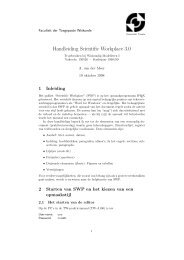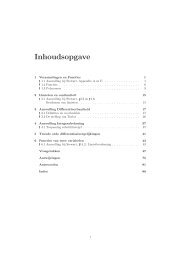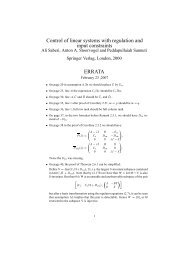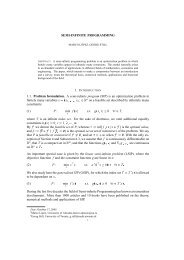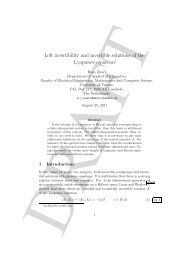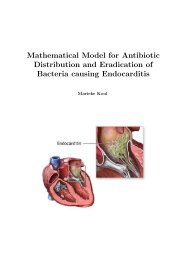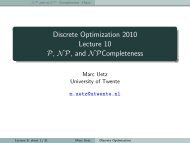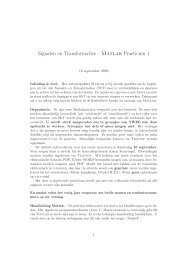Lecture Notes Discrete Optimization - Applied Mathematics
Lecture Notes Discrete Optimization - Applied Mathematics
Lecture Notes Discrete Optimization - Applied Mathematics
You also want an ePaper? Increase the reach of your titles
YUMPU automatically turns print PDFs into web optimized ePapers that Google loves.
augmenting f along P, the flow on edge (u,v) was decreased. That means that the flow<br />
on the reverse edge(v,u) was increased and thus(v,u) must be part of P.<br />
The next lemma shows that for every node v ∈ V, the shortest path distance from s to v<br />
does not decrease.<br />
Lemma 5.5. For each v∈V, δ ′ (s,v)≥δ(s,v).<br />
Proof. Suppose there exists a node v with δ ′ (s,v) < δ(s,v). Among all such nodes, let<br />
v be one with δ ′ (s,v) being smallest. Note that v ≠ s because δ(s,s) = δ ′ (s,s) = 0 by<br />
definition. Let P ′ be a shortest s,v-path in G f ′ of distance δ ′ (s,v) and let u be the secondlast<br />
node of P ′ . Because P ′ is a shortest path and by the choice of v, we have<br />
δ(s,v)>δ ′ (s,v)=δ ′ (s,u)+1≥δ(s,u)+1. (5)<br />
Note that the distance function δ satisfies the triangle inequality. Therefore, edge (u,v)<br />
cannot be part of G f because otherwise we would have δ(s,v)≤δ(s,u)+1. That is,(u,v)<br />
is contained in G f ′ but not contained in G f . Using our observation above, we conclude<br />
that there is some i (1≤i≤k) such that u=v i and v=v i−1 . But then δ(s,v)=i−1 and<br />
δ(s,u)=i which is a contradiction to (5).<br />
Consider an augmentation of the current flow f along path P. We say that an edge e =<br />
(u,v) is critical with respect to f and P if (u,v) is part of the augmenting path P and its<br />
residual capacity coincides with the amount of flow that is pushed along P, i.e., r f (u,v)=<br />
r f (P). Note that after the augmentation of f along P, every critical edge on P will be<br />
saturated and thus vanishes from the residual network.<br />
Lemma 5.6. The number of times an edge e=(u,v) is critical throughout the execution<br />
of the algorithm is bounded by O(n).<br />
Proof. Suppose edge e=(u,v) is critical with respect to flow f and path P. Let δ refer<br />
to the shortest path distances in G f . We have<br />
δ(s,v)=δ(s,u)+1.<br />
After the augmentation of f along P, edge e is saturated and thus disappears from the<br />
residual graph. It can only reappear in the residual graph when in a successive iteration<br />
some positive flow is pushed over the reverse edge(v,u). Suppose edge(v,u) is part of an<br />
augmenting path P ′ that is used to augment the current flow, say f ′ . Let δ ′ be the distance<br />
function with respect to G f ′. We have<br />
By Lemma 5.5, δ(s,v)≤δ ′ (s,v) and thus<br />
δ ′ (s,u)=δ ′ (s,v)+1.<br />
δ ′ (s,u)=δ ′ (s,v)+1≥δ(s,v)+1=δ(s,u)+2.<br />
That is, between any two augmentations for which edge e=(u,v) is critical, the distance<br />
of u from s must increases by at least 2.<br />
34



